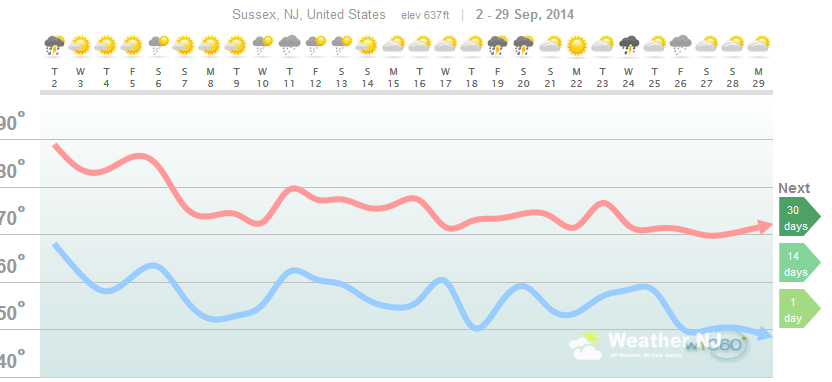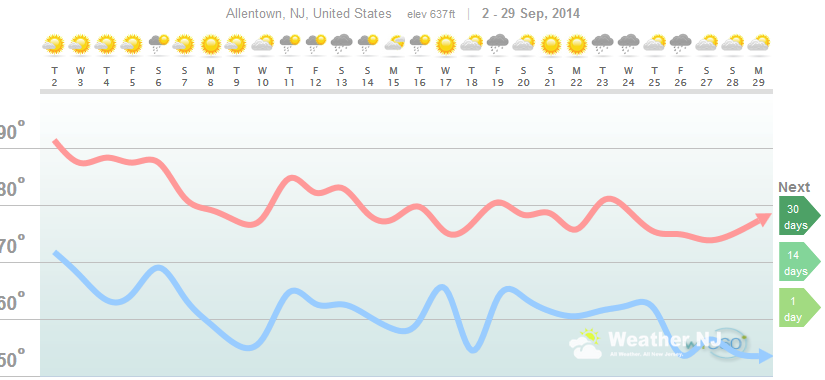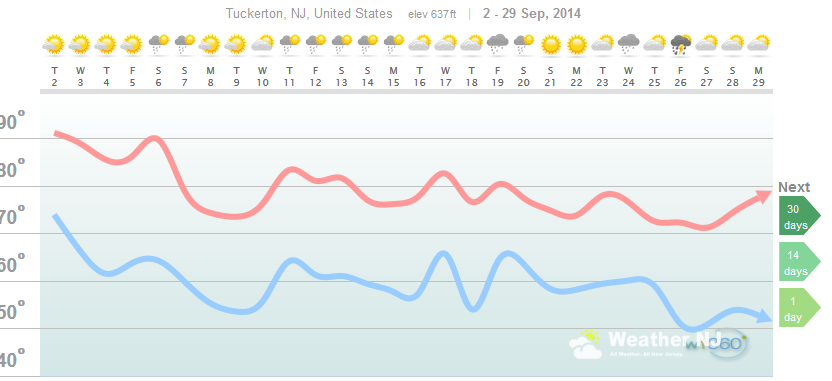Long Range Outlook – September 2014

It’s time to harness the true power of WeatherTrend360’s proprietary algorithms and take a look at the entire month of September. First lets break New Jersey into proper climatological regions. We have the upper elevations of NWNJ, the interior coastal plain (SWNJ through CNJ and into NENJ), and the coastal regions (most of SENJ). I’ll be representing each climatological region with a city/town that represents decent average data for that region. Keep in mind that these algorithms are 84% accurate and are based on oceanic water cycles and time table series. It’s not 100% but it’s the best out there.
Zone 1: Higher Elevations of NWNJ (Sussex, Warren, Hunterdon, Morris, N. Somerset, and N. Passaic) – Known for little to no Atlantic Ocean influence, colder-snowier winters, and drier conditions in general when compared to the coast. This region is known to get hot when high pressure sits overhead during the summer.
Aside from a passing disturbance this Saturday, NWNJ should stay dry for the first 1/3 of September. On-and-off rain showers then look to the haunt the region in the September 10-14 window (common to all three regions). The second half of September (15th-close) looks pretty consistent temperature-wise. Although a hair above average, highs in the 70s and lows in the 50s are expected with stormy periods noted in the 19th-20th and 24th-26th windows.
Zone 2: Interior Coastal Plain (Salem, Gloucester, Camden, W. Burlington, Mercer, W. Monmouth, Middlesex, Union, Essex, Hudson, Bergen, and S. Passaic) – Known for naturally higher temperatures due to lower elevations away from the oceanic influence. This region is also known as “heat island” due to transportation (I-95 corridor), smog, abundant asphalt, concrete, and other man-made structures that naturally absorb heat (Heat Island).
The interior coastal plain looks to start similar to zone 1 for the first 1/3 of September. Mostly sunny skies and dry days are expected aside from a rainy/stormy 6th. The 10th through the 14th looks warm (80s) and wet. Aside from the ~23rd being warm again, most highs should fail to escape the 70s throughout the remainder of the month. Expect 1 or 2 rainy days in the last 10 days of September. Otherwise it should be beautiful with overnight lows in the 50s and 60s.
Zone 3: Coastal Regions (Cumberland, Cape May, Atlantic, E. Burlington, Ocean, and E. Monmouth) – Known for tremendous influence from the Atlantic Ocean. Cooler in the summer and warmer in the winter than the interior coastal plain and especially the higher elevations of NWNJ.
The coastal regions of New Jersey, aside from Friday-Saturday the 5th-6th, should remain mostly sunny and dry. That 10th-14th period looks stormy and wet like the other two regions but might clear for the 13th. The second half of September looks like par for the course with highs in the 70s and lows in the 50s/60s. Some wet periods are noted in the 20th-21st and ~26th windows. The tail end of September could get very fall-like with highs in the 60s and lows in the 40s…everyone ready for that?
Weathertrends360 is a complete, global, web solution to help retailers and suppliers capitalize on the weather and its influence on sales and marketing plans up to a year ahead. Learn how to become PROACTIVE vs REACTIVE with the weather in every phase of your business – how much inventory to buy/produce, where to allocate more/less, when to run weather-optimized advertising/marketing campaigns – weathertrends360 can help you determine all of this in minutes! 84% independently audited accuracy for both short-term and year-ahead forecasts for temperature and precipitation.
A forecast Weather Trends issued one year ago is more accurate than every other weather company’s 5 to 14-day forecasts. The University of Miami and West Point PhD Climatologist’s prove WTI’s year-ahead forecasts are several times more accurate than NOAA – Click to Download Report.
Have a great September and be safe! JC
Jonathan Carr (JC) is the founder and sole operator of Weather NJ, New Jersey’s largest independent weather reporting agency. Since 2010, Jonathan has provided weather safety discussion and forecasting services for New Jersey and surrounding areas through the web and social media. Originally branded as Severe NJ Weather (before 2014), Weather NJ is proud to bring you accurate and responsible forecast discussion ahead of high-stakes weather scenarios that impact this great garden state of ours. All Weather. All New Jersey.™ Be safe! JC











